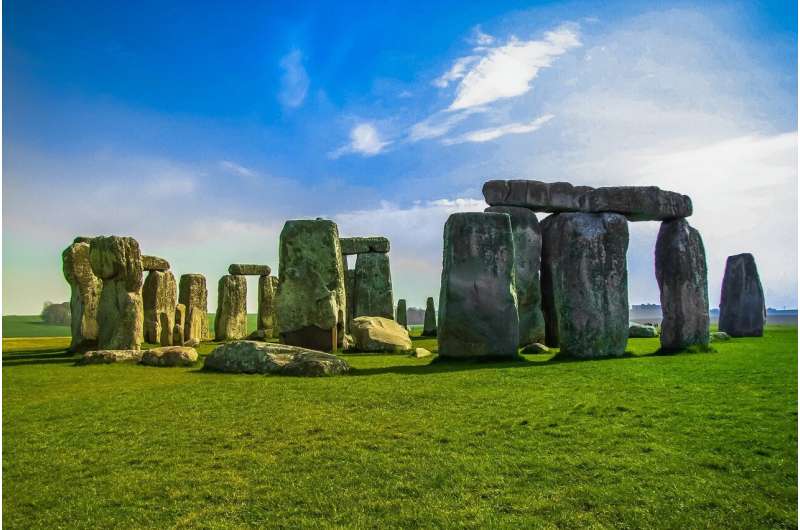
Image credit: Pixabay/CC0 Public Domain
During the solstice, thousands gather at Stonehenge on Salisbury Plain in England to celebrate the monument’s astronomical alignment. The focal point of these celebrations is the Altar Stone – the six-ton sandstone slab that lies flat in the middle of Stonehenge.
The ancient society that built this monument between 3,100 and 1,600 BC left no written records. Yet the building blocks of Stonehenge themselves can help us understand it better. These blocks, or megaliths, are divided into two main categories: sarsen stones and bluestones. The Altar Stone is the largest bluestone.
Some bluestones were probably quarried in Mynydd Preseli in Wales, over 220 kilometres from Stonehenge, while the sarsen stones came from the Salisbury Plain region.
The origin of the altar stone remains a mystery. Recent research has cast doubt on the long-held assumption that it also came from Wales.
So where did the altar stone come from? How was it transported to southern England? To answer this question, we analyzed the mineral grains that make up the altar stone. Our results are now published in the journal Nature– and it looks like the altar stone comes from Scotland.
The DNA of the stones
At dawn on the summer solstice, the altar stone is illuminated by sunlight. On the shortest day, the setting winter sun casts its last rays on it. We can imagine a similar scene at Stonehenge in ancient times, when the prehistoric Britons used it to welcome the prospect of longer spring days and upcoming harvests.
However, apart from this built-in celestial calendar, how and why the monument was built is largely unknown.
Humans are made up of DNA, which tells us our origins, our ancestors, where our family lives, what we eat and the events we have experienced.
Similar to DNA, the altar stone contains a large number of mineral grains that contain information about their formation (crystallization) and their subsequent history (transport and metamorphism).
In our study, we dated mineral grains called zircon, rutile and apatite in the Altar Stone. Since sampling of the Altar Stone is no longer permitted today, we used thin slices of the stone collected during historical archaeological excavations.
Just as a DNA test can tell us where our ancestors came from, the grains in the altar stone have a specific age and chemical properties that allow us to determine their original rock. We do this by comparing these details with rocks in other locations.
Based on matching characteristics, we have located the source of the grains in the Altar Stone: the best match was sedimentary rocks in the Orkney Basin in northeast Scotland.
The Grampian Mountains and the Northern Highlands shed tiny bits of rock, or debris, towards the Orkney Basin around 400 million years ago. These eroding rocks transferred their unique and traceable ‘DNA’ into the sandstone that was eventually chosen as the altar stone.
The Scottish heart of Stonehenge
Today, north-east Scotland and the Orkney Islands are sparsely populated, but this was not the case in the past. Archaeological sites such as Skara Brae, Maeshowe and the Ring of Brodgar on a ritual landscape in the Orkney Islands suggest that north-east Scotland was a centre of Neolithic population, culture and trade.
The assumption that the altar stone came from Scotland raises fascinating questions about the interconnectedness and technological capabilities of prehistoric Britain.
A trade network for quarry tools exists throughout Britain, Ireland and continental Europe. For example, a saddle mill, a large prehistoric stone grinding tool, has been discovered in Dorset and must have come from Normandy in France.
How did the altar stone get to Stonehenge?
Although some believe that the Welsh bluestones may have been transported to Stonehenge by glaciers, this transport seems unlikely for the Altar Stone.
During previous ice ages, massive walls of ice moved north from the mountains of Scotland toward the Orkney Basin – transporting rock even further away from the Salisbury Plain.
But the Neolithic Britons were experienced seafarers. This was no different, as prehistoric Britain was characterized by dense forests and huge mountains, valleys and river mouths would have made the transport of goods southwards very difficult.
Given these obstacles, overland transport to bring the Altar Stone from Scotland to Salisbury Plain would have been almost impossible. We think it likely that the builders of Stonehenge shipped the Altar Stone by boat.
There is precedent for this. The remains of the Hanson Log Boat provide evidence that shaped sandstone blocks were transported on the river as early as 1500 BC.
The unanswerable question is why people chose the altar stone. Why was a grey-green, six-ton block of sandstone transported over 650 kilometres from Scotland?
People have long been searching for the perfect stone for their construction, and this desire continues to this day.
American socialite Kim Kardashian spent thousands on luxurious Calacatta gold marble from Italy for her Los Angeles mansion. For us, this choice is undoubtedly extravagant, perhaps incomprehensible, given that local stone was available.
Perhaps the average Neolithic Briton felt the same way about the Altar Stone. Or perhaps there was a more mundane reason. Perhaps the rock was so jagged that it could be easily quarried and transported along nearby shipping routes.
Provided by The Conversation
This article is republished from The Conversation under a Creative Commons license. Read the original article.![]()
Quote: Stonehenge altar stone came from unexpectedly distant location, new study shows (August 17, 2024), accessed August 17, 2024 from https://phys.org/news/2024-08-altar-stone-stonehenge-unexpectedly-distant.html
This document is subject to copyright. Except for the purposes of private study or research, no part of it may be reproduced without written permission. The contents are for information purposes only.

